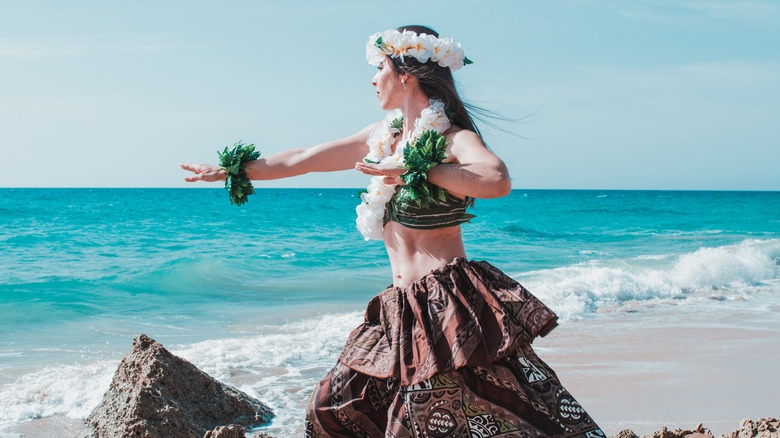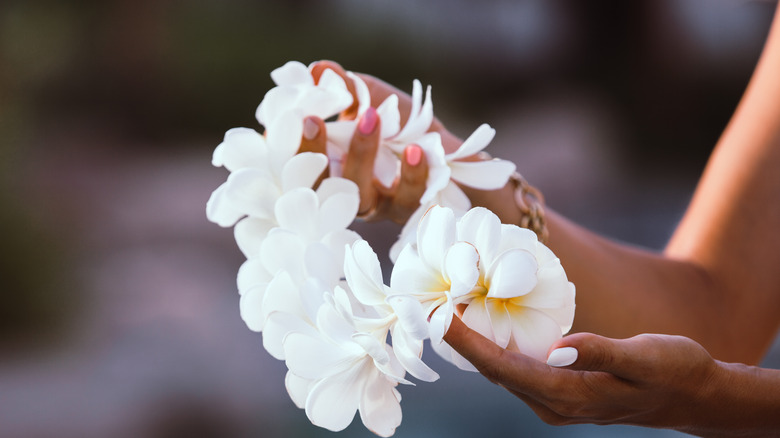The Heartwarming History Of Hawaiian Leis
The lei has become synonymous with a Hawaiian vacation. When you receive a lei around your neck, the beautiful garland of stringed flowers marks the end of a long flight and an "aloha" from the Hawaiian people. And aloha is a more accurate word than hello. While aloha is commonly used as a simple greeting, the word's literal translation represents deeper spiritual and cultural meaning for Hawaiians. According to an article by PBS, "alo" translates to "in the presence," while "ha" means "the breath of life."
Much like the word aloha, the lei is more than a selfie-stick decoration or tourist welcome. The lei's history and cultural significance are as fragrant as the garland themselves. In fact, the lei is the physical representation of the aloha spirit, according to Ke Ola Magazine. With that in mind, it's easy to understand why the lei is more than a souvenir. It represents life itself.
The custom of leis didn't originate in Hawaii
From the 8th to 14th centuries, Polynesian voyagers from Tahiti introduced the custom of leis to the Hawaiian islands, according to Ke Ola Magazine. It's fairly easy to prove this, as leis and lei traditions were common throughout the Pacific islands. Over time, Hawaiians began their own lei traditions, which became important to sacred ceremonies and community celebrations. In addition to flowers, tradition leis have been made of feathers, shells, nuts, and animal bones. Feather leis, in particular, were adornments reserved for the ali'i, or Hawaiian royalty, according to an article in Maui Magazine.
In more recent history, the tradition of giving leis to arriving tourists began in the "boat days" of Hawaii. According to the Hawaiian Lei Company, the "boat days" for Hawaiians refers to the time between the late 1800s and early 1900s, when tourism to Hawaii first become popular. Since airplanes were barely flying the length of a football field during this time, all tourists arrived by boat. Upon arrival, vendors sold leis at the docks to welcome visitors. Orchid leis are typically given as a welcome, which popularized the flowery garlands we think of today. For good luck, it was also customary for departing travelers to throw their leis overboard. If the lei made it safely to shore, their boat would do the same.
Lei faux pas and giving in to the Spirit
Although we consider receiving a lei around our neck as standard, this method of presentation is actually pretty recent, according to Ke Ola Magazine. Traditionally, a person would simply give someone a lei, as it would be considered rude to place your hands above someone else's head. Also, while casting your lei into the ocean, much like in the "boat days," is acceptable, tossing your lei in the trash is considered disrespectful. After all, someone went through painstaking handiwork to create the meaningful garland for you. If you do eventually dispose of your lei, it's tradition to return them back to nature by tossing the lei into the ocean, burying them, or burning them, says Aloha Island Lei.
However, the worst faux pas, says Hawaiian Lei Company, is to refuse a lei. When you consider that a lei is the physical manifestation of aloha, or the breath of life, it's no surprise that refusing a lei would be taboo. So, if you're the type of traveler who scoffs at "touristy" things, remember that receiving a lei is not like putting on Mickey Mouse ears. It's the aloha spirit, and you're welcomed to it.


